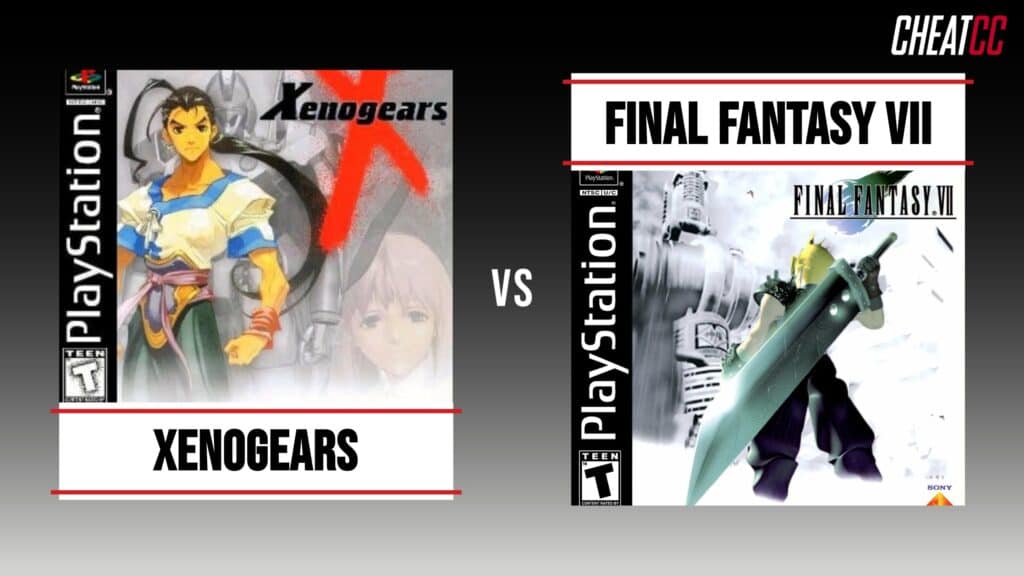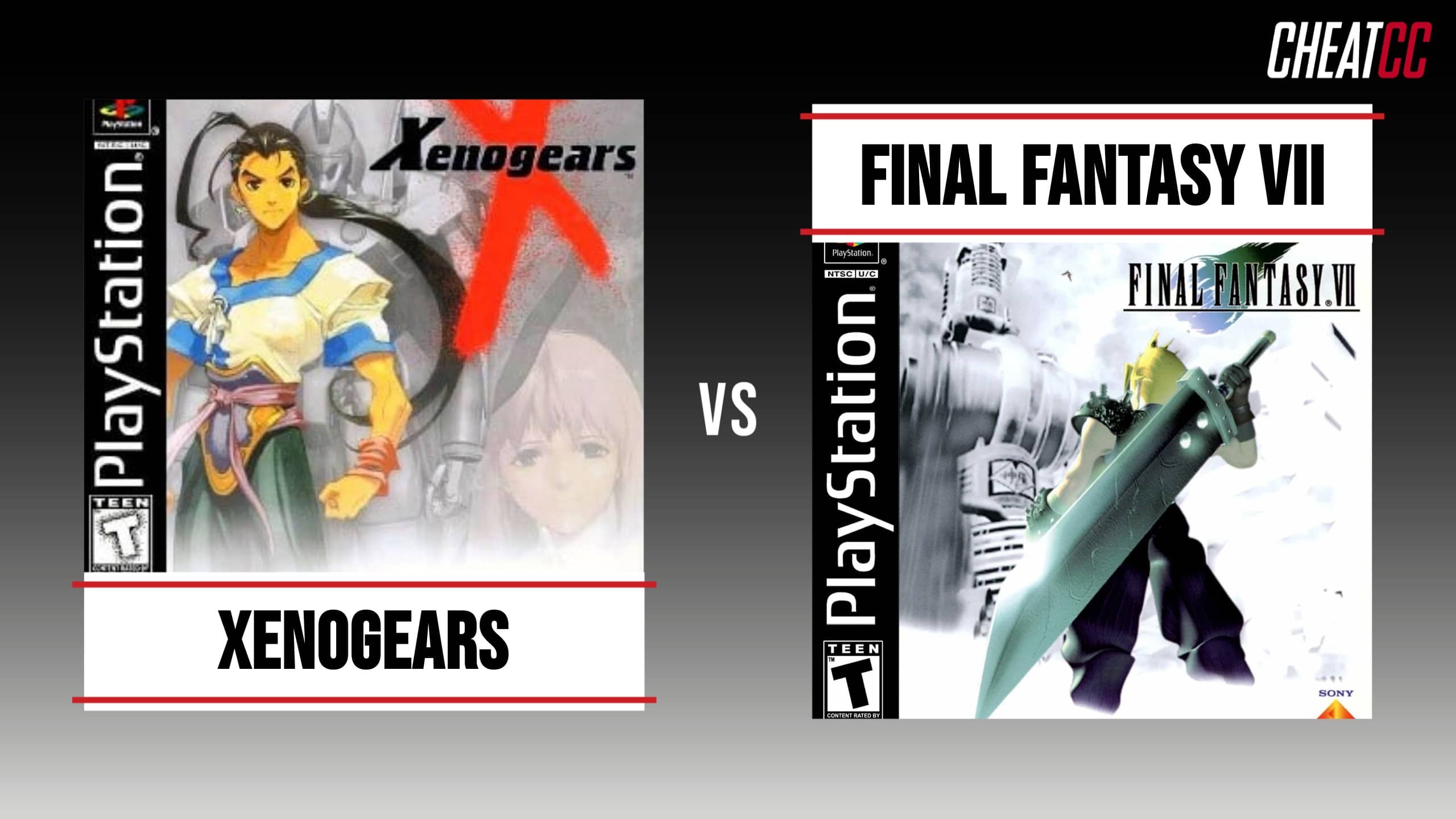Square’s legendary PS1 catalog is one of the most consistent and noteworthy periods of output of any developer. Not only does this era see the arrival of the first 3D Final Fantasy game, it also is the time period in which Square would be more prolific than any other point in the company’s history, all while showcasing a willingness to experiment and push the envelope of what’s possible in a console RPG. Three Final Fantasy titles, a series of successful spin-offs, and the beginnings of several franchises chart their genesis back to Square’s PS1 library, including Tetsuya Takahashi’s groundbreaking Xenogears. In terms of the title for best PS1 RPG, its arguable a battle of Xenogears vs Final Fantasy VII.
After originating as the early concept for Final Fantasy VII, Xenogears would go on to become its own standalone title, featuring a high-concept sci-fi plot rife with references to philosophy, psychology, and religion. Despite (or perhaps because of) the game’s lofty narrative, it continues to endure as one of the highlights of Square’s catalog, but the same is true of Final Fantasy VII. As the first 3D game in the series (and the first to debut on a non-Nintendo console), Final Fantasy VII is inarguably one of the most important games of all-time. With both games exhibiting the highlights of one of Square’s most prolific and important eras, it’s time to see which is the definitive PS1 RPG.
Xenogears vs Final Fantasy VII: Side-by-Side Comparison

For all the differences that exist between the two games, Xenogears and Final Fantasy VII share a few commonalities. Xenogears began its existence as the original version of Final Fantasy VII before being deemed too niche for a wide audience, while Final Fantasy VII is still a drastic departure from the series’ first 6 titles, bringing the franchise firmly into the future with its setting, plot, and characters. However, while both games are turn-based JRPGs from Square, their mechanics and gameplay could not be more different from one another. Additionally, Xenogears‘ success is a far cry from that of Final Fantasy VII, which would end up being one of the driving forces behind the PlayStation’s victory over the 5th generation “console wars”.
| Characteristic | Xenogears | Final Fantasy VII |
|---|---|---|
| Release Date | February 11, 1998 (JP) October 20, 1998 (NA) | January 31, 1997 (JP) September 7, 1997 (NA) |
| Publisher | Squaresoft | Squaresoft, Sony Computer Entertainment |
| Director | Tetsuya Takahashi | Yoshinori Kitase |
| Review Aggregate Score | 91% | 92% |
| Total Sales | 1.46 million units | 14.14 million units |
| Remake/Remaster | N/A | Final Fantasy VII PC version, Final Fantasy VII Remake Trilogy |
| Graphical Style | 2D character sprites on full-3D backgrounds | 3D character models on pre-rendered 2D backgrounds |
| Combat | Turn-based with button commands | Turn-based with menu selection |
| Narrative Themes | Freudian Psychoanalysis, Gnosticism, Reincarnation, Multiple Personality Disorder | Industrial Revolution, Late-Stage Capitalism, Environmental Conservation, Mental Health and Identity |
| Legacy | Cult-classic Square RPG, developers would found Monolith Soft and create the Xenosaga and Xenoblade series | First 3D Final Fantasy, first game in the series to embrace dystopian future setting, fan-favorite game in the series and many players’ first RPG |
Xenogears vs Final Fantasy VII: 5 Must-Know Facts
Here are 5 must-know facts when comparing Xenogears to Final Fantasy VII:
- Despite both games coming out on the PS1 just a year apart, Xenogears and Final Fantasy VII feature polar opposite graphical styles. While Final Fantasy VII features polygonal 3D characters over pre-rendered 2D backgrounds, Xenogears utilizes hand-drawn 2D character sprites over full-3D backgrounds that players can rotate the camera around.
- Both Xenogears and Final Fantasy VII incorporate traditional JRPG combat, but Xenogears‘ enhances its ability to engage players through the use of button commands. Additionally, Xenogears features two separate combat models, with both on-foot and Gear combat.
- Xenogears charts its existence back to 1994 when directory Tetsuya Takahashi and future wife Kaori Tanaka (now going under the pen name Soraya Song) would begin developing it as the basis for the early concept of Final Fantasy VII. Realizing that the project might be too niche and lofty for a wide audience, Takahashi would then envision the game as a sequel to Chrono Trigger before eventually being given his own team to develop Xenogears as a standalone title.
- The protagonists of Final Fantasy VII and Xenogears rank among some of the most compelling tragic heroes to ever feature in a Square RPG, and they both also happen to struggle with significant mental health crises and cases of identity confusion.
- Final Fantasy VII‘s sales place it as the most successful single-player game in the series, which continues to this day through the Final Fantasy VII Remake‘s impressive sales figures. Conversely, Xenogears holds roughly one tenth the total sales figures of just the PS1 vesion of Final Fantasy VII, failing to reach a mainstream audience but retaining a loyal cult following.
Xenogears vs Final Fantasy VII: 2D and 3D Differences
Xenogears‘ use of 2D character sprites over 3D backgrounds helps the game to withstand the test of time and age gracefully, while Final Fantasy VII‘s opposite graphical style is unquestionably a product of its time. Pre-rendered backgrounds are interesting in that they essentially rose to prominence and were then perfected within the PlayStation’s generation, never to appear again in any significant capacity. As a result, the original Final Fantasy VII definitively shows its age with its blocky 3D character models and backgrounds that call to mind a graphical style that is now out of vogue. Thanks to the original’s comparatively primite graphics the other PlayStation Final Fantasy games, the Final Fantasy VII Remake is one of the most impressive reimaginings of a classic.
Xenogears vs Final Fantasy VII: Turn-Based Gameplay
JRPGs are synonymous with turn-based combat, and Square is synonymous with the JRPG subgenre. Accordingly, both Final Fantasy VII and Xenogears feature combat similar to Square’s other RPGs, but Xenogears decidedly takes things a step furhter to feature one of the most unique and engaging combat models of any PS1 RPG. Firstly, players are able to engage in battles both on-foot and within the game’s mecha, the titular Gears. Both battle systems have their fair share of nuance between them, though the common feature they share is requiring players to input manual button commands to execute attacks. As players use combos, they level up their skill and unlock even more powerful abilities to use against foes.
Xenogears vs Final Fantasy VII: Origins of Both Titles
The development and release of Final Fantasy VI would prove to be one of the most definitive moments in the history of Square, with several of the staff working on the game going on to be part of or lead the teams that would create some of the company’s most ground-breaking titles during the 32-bit era. The scenarios and original concepts for both Final Fantasy VII and Xenogears would come to fruition in the minds of both games’ directors after their experiences working on previous Final Fantasy titles, and Xenogears would even be the original concept of both Final Fantasy VII and a scrapped Chrono Trigger 2 before eventually becoming its own standalone title.
Xenogears vs Final Fantasy VII: Compelling Narratives and Protagonists
Final Fantasy VII‘s Cloud is one of the most iconic and recognizable heroes in all of gaming, while Fei Fong Wong is an excellent and relatable main character that successfully embodies many of Xenogears underlying thematic elements. In terms of PS1 games, Xenogears is notorious for its incredibly lofty narrative that incorporates elements of philosophy, anthropology, religion, psychology, and spirituality to present something wholly unique in Square’s vast catalog. Similarly, Final Fantasy VII is the first game in the long-running flagship series to boldy take the franchise into the future and past the industrial revolution, addressing themes that are less universal and more topical to the real-world.
Bottom Line
For RPG fans, it doesn’t get much better than Square’s impressive library of titles that release between 1991 and 2001. The 1990s exist as the company’s best period, producing some of the all-time greats of the genre and solidifying Square as the front-runner of the RPG genre. Two of the titles embodying the company’s creative peak are Xenogears and Final Fantasy VII, though in terms of which is the definitive PS1 RPG, only one game can hold the honor. While many (present company included) might choose Xenogears as their personal favorite RPG on the console, it almost goes without saying that Final Fantasy VII is one of the most important games to ever release.
The context surrounding Final Fantasy VII‘s development and release, as well as the shock of Square moving away from Nintendo to exclusively release the next game in its main franchise on Sony’s new console, make Final Fantast VII more than a game release and arguably an important footnote in history. Between its impressive sales, enduring place as a fan-favorite in one of gaming’s longest-running franchises, and willingness to take the series into a bold new direction, Final Fantasy VII stands as the definitive RPG on the PS1. Fans can argue over which game is truly “better”, but it’s Final Fantasy VII and not Xenogears that drives the sale of millions of PlayStation consoles.
